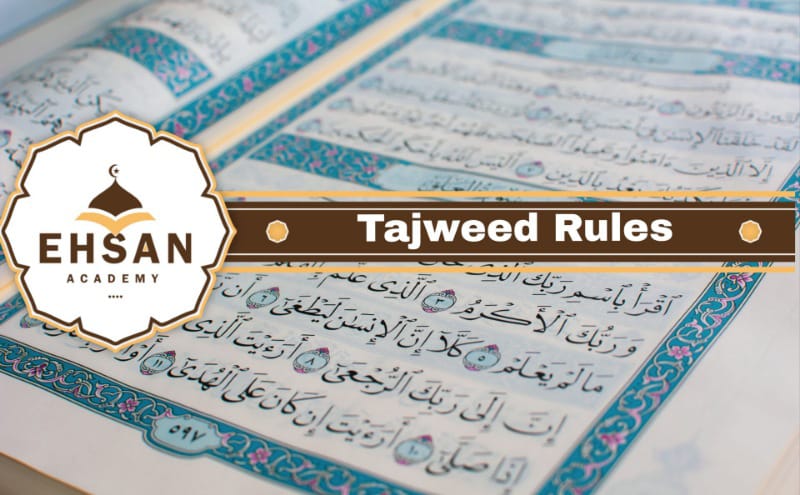as we know applying tajweed rules is very important to have a proper Quran recitation and we shouldn’t forget that when we apply the rules of tajweed, we read Quran as it was revealed from Allah (SWT) to our beloved prophet (PBUH) so, in this articles we will explain these three rules Madd rules / Al Qalqlah / Arabic heavy letters
Tajweed Rules and Arabic letters
To Know how to do the Quran reading with Tajweed and its correct application. Ehsan Academy’s Online Quran recitation course with Tajweed helps you master even the smallest details with perfection. Try the free classes today!
Each Arabic letter has a pronunciation that requires mastering the articulation points. After learning the characteristics of each letter such as shape, size, sound, and pronunciation, one should focus on vowels and their characteristics.
The correct understanding of the short and long vowels is necessary to learn to read Quran with a decent tajweed. The quality of the short and long vowels is the same, but their quantity varies.
Table of Contents
1- Madd rules
Madd rules are one of the most important rules in Tajweed in order to have an ideal Quran recitation the first step is to learn how to apply Tajweed rules during the recitation of Quran and now we will mention in general to all Madd rules besides mentioning in deep details to the most important ones.
What is Madd
In Tajweed, Madd refers to the elongation of certain vowel sounds in the Quran. The word “Madd” means “stretching” or “elongation” in Arabic. There are three types of Madd in Tajweed:
Madd letters are : Alif (ا), Waw (و), Ya (ي),. These letters can be elongated when there is fatha(َ) before the alif or kasrah (ِ) before the ya or Dammah (ُ) before the Waw.
Huroof Al Madd are three letters :
- Alif (ا) if it’s preceded by Fatha. (ex: قَال)
- Ya’ (ي) if it’s perceded by kasrah (ex: فِيه)
- Waw ( و) if it’s perceded by dammah (ex: قالٌو)
Types of Madd :
Madd rules are 10 types, divided into
A- Madd Al Asli (Tabee’ee): This is the primary one that is needed to pronounce any word and it occurs when there one of the three letters of Madd (Alif (ا), Waw (و), Ya (ي),. and they are not followed or preceded by Hamzah or sukoon
B- Madd al far’i ( secondary madd): This type is divided into another 5 types:
1- Madd Al Muttasil 2- Madd Al-Munfasil 3- Madd Laazim 4- Madd Aaridh li-ssukoon 5- Madd al Badal
C- other Madd types :
1- Madd Al leen 2- Madd Al Ewadh 3- Madd Silah Sughra 4- Madd Silah Kubra
through we mentioned we know that the Madd types are 10 types
Now we are going to go in more detail in Madd rules
Madd Al Asli (Long Madd):
This type of Madd is represented by a horizontal line written above a letter. The letter can not exist without applying it. so it is the Madd that needed to pronounce the letter itself. and it is elongated for two vowel counts.
this Madd occurs when we have one of the three letters of Madd (Alif (ا), Waw (و), Ya (ي),.are not followed or preceded by Hamzah or sukoon. in this case, the letter Madd will be elongated for two vowel counts.
Madd Al Far’i (Secondary Madd):
This type of Madd is represented by a vertical line written above a letter. The letter is then elongated for four vowel counts and there are five types of this madd.
first, we need to know that to apply these 5 types of Madd we have to have two conditions
1- letter of Madd
and it is one of three ( alif (ا) or waw (و) or ya (ي)
2- reason of Madd
and it can be Hamzah (ء) or sukoon, the sign on the top of the letter (لْ)
-Three types of them their Madd reason is Hamzah and they are
1- Madd Al-Badal
2- Madd Al Muttasil
3- Madd Al Munfasil
-Two types of them their Madd reason is sukoon and they are
1- Madd Aaridh li ssukoon
2- Madd Laazim
we will explain some of them below :
1- Madd Al Badal
Madd Al-Badal is a rule of recitation in Tajweed that involves the elongation of a letter in the Quran to replace another letter. The word “Badal” means “replacement” in Arabic, and this rule is used when one of the three letters of Madd appears after Hamzah in one word and there is no Hamzah or sukoon after th the letter of Madd.
The Madd Al-Badal rule applies to the following
when there are one of three letters of Madd Alif or Waw or Ya ( ا – و – ي ) comes after Hamzah(ء) in one word and there is no sukoon or Hamzah after the letter of Madd
Madd AL Badal exemples
ءاية – أوتينا – ءانية
How long we extend Madd Al Badal?
we extend it for two Harakat or beats.
The proper application of Madd Al-Badal is important in Tajweed to ensure the correct pronunciation of words in the Quran. The accurate application of this rule requires an understanding of the pronunciation of Arabic letters and diacritical marks used in the Quran, as well as the other rules of Madd and Tajweed.
In conclusion, Madd Al-Badal is a rule of recitation in Tajweed that involves the elongation of a letter in the Quran to replace another letter that cannot be pronounced with Madd. The proper application of this rule is important in Tajweed to ensure the correct pronunciation of words in the Quran and to preserve the original text of the Quran.
2- Madd Al Muttasil :
- Madd AL Muttasil is when you have one of the three letters of MADD ( ا & و & ى ) and Hmazah (ء) in one word.
- examples of Madd AL Muttasil : السمَاء – سُوء – تفِيء
so if we look at these examples we will notice that the Hamzah comes after the letter of madd in the same word, Madd AL Muttasil we have to apply it when we recite the Quran.
- How much should we prolong Madd AL Muttasil?
we should prolong 4 or 5 beats. and 6 beats in case of stopping on the word
3- Madd Al Munfasil .
- Madd Al-Munfasil is when you have one of the three letters of madd ( ا & و & ى ) in a word and Hmazah (ء) in the next word.
- examples of Madd Al-Munfasil : هُوَ ٱلَّذِى أَخْرَجَ- وَظَنُّو أَنَّهُم – فَمَا أَوْجَفْتُمْ عَلَيْهِ
- How much should we prolong Madd Al Munfasil?
we should prolong Madd AL Munfasil 4 or 5 beats.
In conclusion, the Madd rules in Tajweed refer to the elongation of certain vowel sounds in the Quran.
Madd rules are one of the most important rules in Tajweed in order to have an ideal Quran recitation the first step is to learn how to apply Tajweed rules during the recitation of Quran and now we will mention in general to all Madd rules besides mentioning in deep details to the most important ones.
FAQS
How many types of madd?
types of madd are ten types and they are
1- Madd Tabee’ee: this the one that the letter can not be pronounced without it and it comes when the three letters of madd ( alif or waw or ya’ ) come without Hamzah or sukoon before or after
2- Madd Al Badal: this Madd is when the Hamzah comes before the three letters of Madd
3- Madd Ewadh: this one Comes when we stop on a tanween double Fatha and we prolong it for 2 beats
4- Madd Aaridh li ssukoon: this one comes when there is a temporary sukoon comes after the letters of Madd and you prolong for 2 or 4 or 6 beats
5- Madd Al leen: this Madd comes when the waw sakinah or ya’ sakinah is preceded by fatha followed by temporary sukoon and you prolong for 2 or 4 or 6 beats
6- Madd Al Muttasil: this one comes when the Hamzah comes after one of the three letters of Madd in one word and you prolong for 4 or 5 beats
7- Madd Al Munfasil: this one comes when the Hamzah comes in the next word after one of the three letters of Madd, the letter of Madd in a word, and the Hamzah in the next word and you prolong for 4 or 5 beats
8- Madd Laazim: this Madd comes when a permanent sukoon comes after the three letters of Madd in one word and you prolong for 6 beats
9- Madd Silah Sughra: this one is when an extra Ha’ of a word comes at the end of this word, between two vowels and we prolong it for 2 beats
10- Madd Silah Kubra: this one is when an extra Ha’ of a word comes at the end of this word, between two vowels and the second vowel is Hamzah and you prolong for 4 or 5 beats
What is madd in tajweed?
Madd in Tajweed is extending the sound of the three letters of Madd and Madd is divided into eight types
Is there any resources for learning Tajweed rules?
there are many resources available for learning Tajweed rules. Here are some of the resources that you can use to learn Tajweed:
Online Courses: There are many online courses available that teach Tajweed rules. These courses can be accessed from anywhere in the world and allow you to learn at your own pace. Some popular online courses include Quranic Arabic Foundation, Bayyinah TV, and Quranic.
Tajweed Books: There are many Tajweed books available that can help you learn the rules of Tajweed. Some popular Tajweed books include “Tajweed Rules of the Quran” by Kareema Carol Czerepinski and “The Rules of Tajweed” by Muhammad Salih al-Munajjid.
Tajweed Apps: There are many Tajweed apps available that can help you learn Tajweed rules on your mobile device. Some popular Tajweed apps include “Tajweed Quran” and “Al-Quran Tajweed”.
Tajweed Classes: Many mosques and Islamic centers offer Tajweed classes for people who want to learn the rules of Tajweed. These classes are usually taught by qualified teachers and provide a structured learning environment.
YouTube Videos: There are many Tajweed videos available on YouTube that can help you learn Tajweed rules. Some popular YouTube channels that teach Tajweed include “Quranic”, “Al-Quran Institute”, and “Learn Quran Tajweed”.
How do i know if I’m applying Tajweed rules correctly?
There are several ways to tell if you are applying Tajweed rules correctly:
Seek Feedback from a Qualified Teacher: The most effective way to know if you are applying Tajweed rules correctly is to seek feedback from a qualified Tajweed teacher. A teacher can listen to your recitation, point out any mistakes, and provide guidance on how to improve your Tajweed.
Record Your Recitation: You can record your recitation of the Quran and listen to it to identify any mistakes or areas for improvement. This can help you to identify any issues with your pronunciation, intonation, or rhythm.
Use Tajweed Resources: There are many Tajweed resources available, such as books, apps, and online courses, that can help you learn and apply Tajweed rules correctly. You can use these resources to check your understanding of Tajweed and ensure that you are applying the rules correctly.
Attend Tajweed Classes: Attending Tajweed classes can help you to learn and apply Tajweed rules correctly, as you can receive feedback from a qualified teacher and practice your recitation in a structured environment.
Practice Consistently: Practicing Tajweed consistently is essential for improving your recitation and applying Tajweed rules correctly. You can practice by reciting the Quran regularly, listening to recitations by qualified reciters, and reviewing Tajweed rules and resources.
In conclusion, there are several ways to tell if you are applying Tajweed rules correctly, including seeking feedback from a qualified teacher, recording your recitation, using Tajweed resources, attending Tajweed classes, and practicing consistently. By using these methods, you can improve your Tajweed, deepen your understanding of the Quran, and enhance your spiritual connection to Allah.







